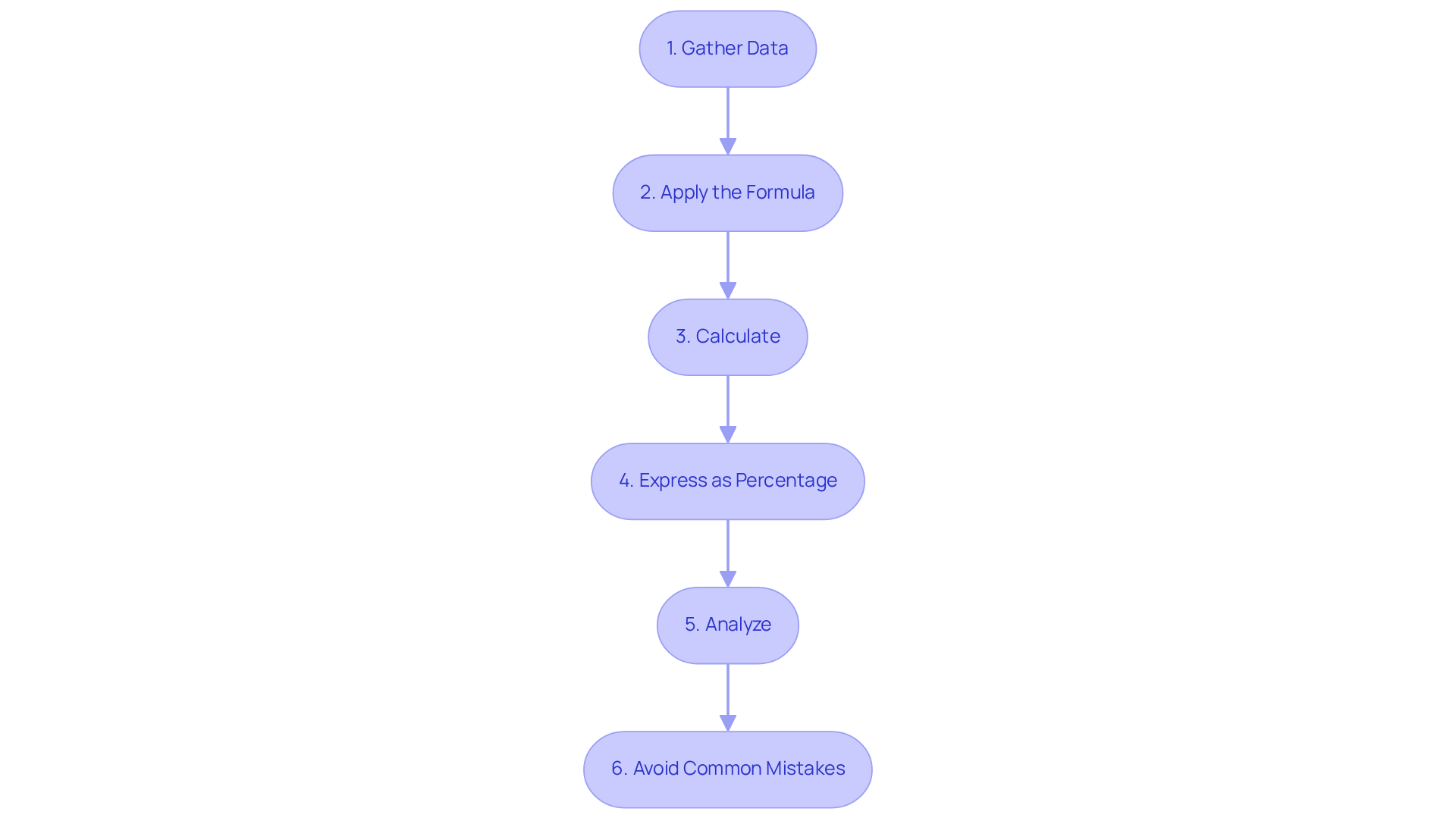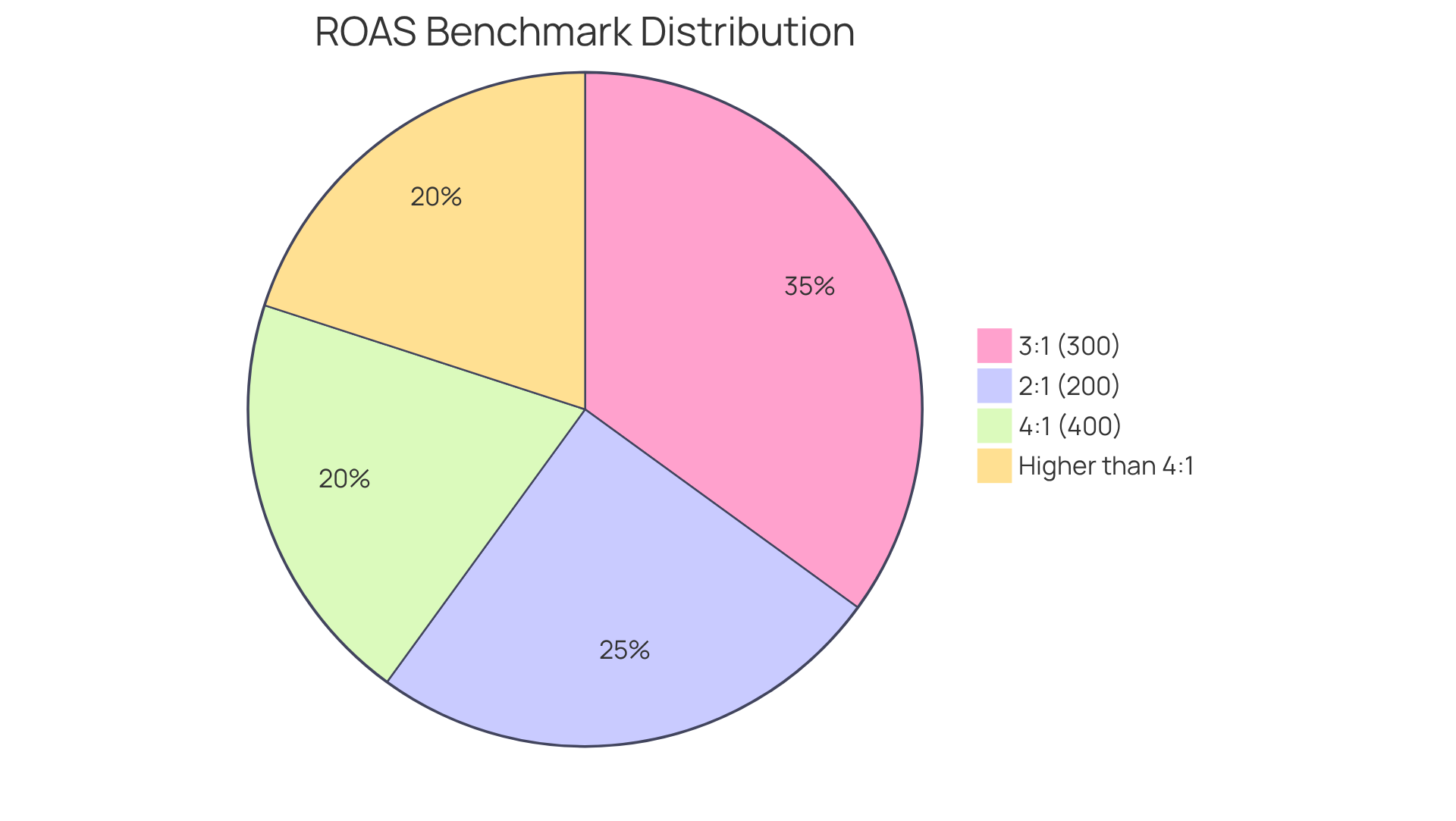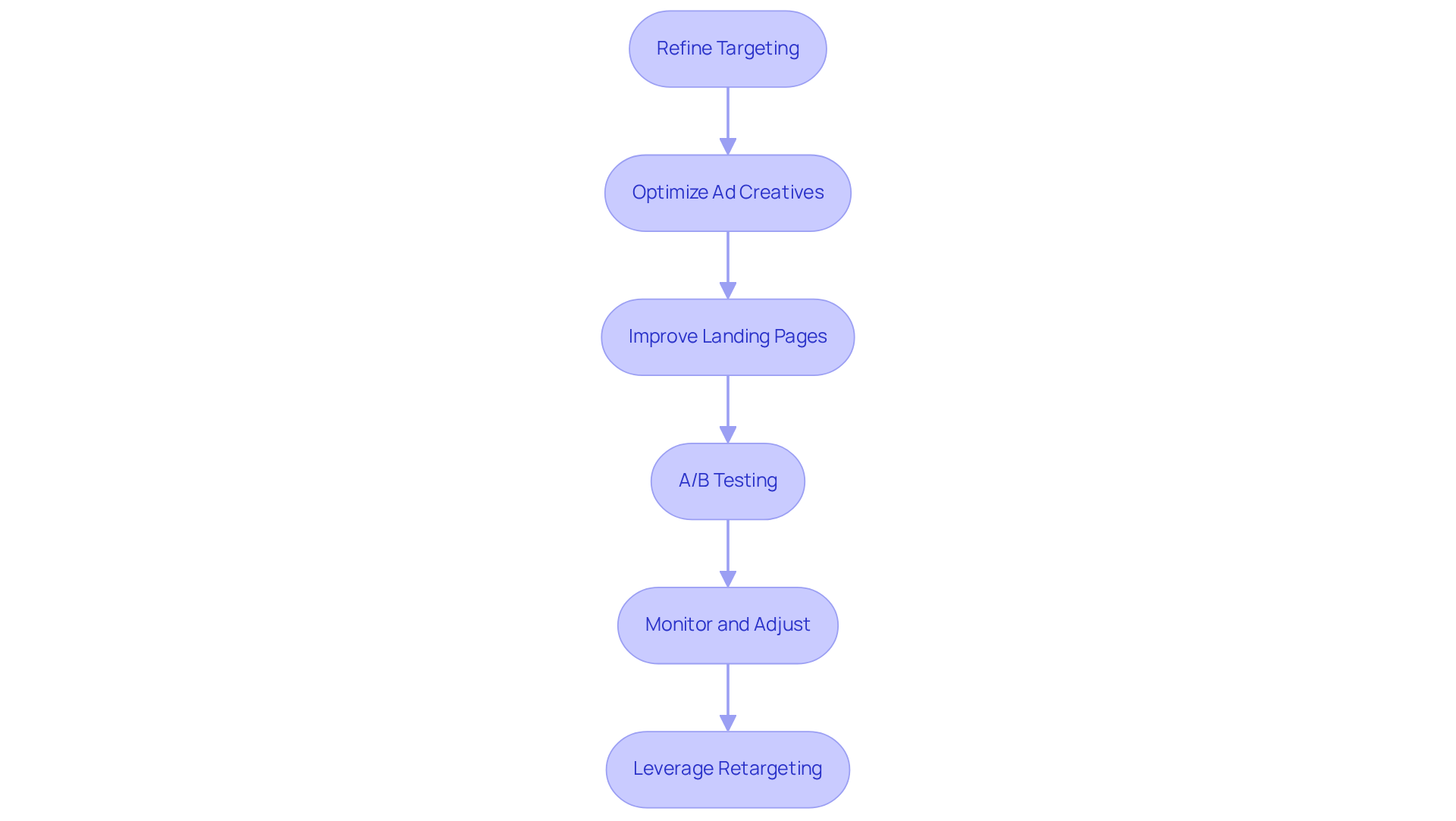
Overview
Mastering the ROAS (Return on Ad Spend) formula is essential for marketers aiming to enhance their advertising effectiveness. Understanding ROAS is not merely beneficial; it is crucial for driving better marketing outcomes and increasing profitability. This article provides a straightforward calculation method that enables marketers to assess their advertising performance effectively.
To calculate ROAS, one must divide the revenue generated from ads by the total ad spend. This simple formula lays the groundwork for deeper analysis and improvement. However, the journey does not end with calculation; it is imperative to refine targeting and optimize ad creatives. These strategies are pivotal in increasing ROAS, leading to more impactful marketing efforts.
By implementing targeted strategies and continuously optimizing advertising content, marketers can significantly improve their results. The emphasis on understanding and applying the ROAS formula equips professionals with the tools necessary to make informed decisions and drive profitability. In conclusion, mastering ROAS is not just about calculation—it's about leveraging that knowledge to enhance advertising strategies and achieve superior marketing results.
Introduction
Understanding the intricacies of Return on Ad Spend (ROAS) is crucial for any brand aiming to maximize the effectiveness of its advertising campaigns. This powerful metric quantifies the revenue generated for every dollar spent and serves as a guiding light for marketers navigating the complex landscape of digital advertising. However, as privacy regulations and evolving consumer behavior reshape the marketing environment, brands must leverage ROAS effectively.
By exploring the ROAS formula, its calculation, and proven strategies for enhancement, essential insights emerge that can drive profitability and optimize ad spend.
Define ROAS: Understanding Return on Ad Spend
The roas formula is a critical performance indicator that quantifies the income generated for each unit spent on promotional activities. The calculation is straightforward:
ROAS = Revenue from Ads / Cost of Ads
This ratio effectively illustrates how well an advertising campaign transforms expenditure into revenue. For instance, if a campaign generates $5,000 in revenue at a cost of $1,000, the return on ad spend would be 5:1, indicating that for every dollar invested, five dollars are earned.
Understanding the roas formula is essential for marketers, especially for direct-to-consumer (DTC) brands, as it enables the assessment of and informed budget allocation decisions. In practice, brands that focus on enhancing their return on advertising spend often utilize the roas formula and frequently witness significant improvements in their overall marketing effectiveness. A notable example is a DTC brand that partnered with Parah Group, which made strategic adjustments based on return on ad spend insights and reported a 36% increase in ROI on their promotional expenditures.
Marketing professionals stress the importance of evaluating the roas formula in conjunction with other metrics, such as Customer Acquisition Cost (CAC) and Average Order Value (AOV). As one expert aptly noted, 'The roas formula indicates how much revenue is generated for every dollar spent on promotion, but it neglects to consider the actual costs involved.' This underscores the necessity for a holistic approach to assessing advertising performance.
Moreover, the evolving landscape of digital marketing, characterized by privacy regulations and the phasing out of third-party cookies, complicates the calculations involved in the roas formula. Therefore, brands are encouraged to continually monitor their return on advertising spend, adjusting strategies as necessary to enhance both advertising returns and overall profitability—a practice that Parah Group actively supports through innovative conversion rate optimization strategies.
To collaborate with Parah Group, brands should possess a minimum of 100,000 website visitors per month and 2,000 purchases or conversions monthly. This threshold ensures sufficient traffic and conversions to conduct effective split testing, thereby maximizing the impact of CRO efforts.

Calculate ROAS: Step-by-Step Guide
To effectively calculate ROAS, adhere to the following steps:
- Gather Data: Begin by collecting the total earnings generated from your promotional campaign alongside the overall expenses incurred.
- Apply the Formula: Utilize the ROAS formula:
ROAS = Revenue from Ads / Cost of Ads - Calculate: For instance, if your campaign generated $10,000 in revenue and incurred $2,000 in costs, the calculation would be:
ROAS = $10,000 / $2,000 = 5. This indicates you earned $5 for every dollar spent on advertising. - Express as Percentage: To express your return on ad spend as a percentage, multiply the result by 100. In this example, it would yield 500%.
- Analyze: Leverage this information to evaluate the effectiveness of your ad spend. A return on advertising spend of 4:1, determined by the ROAS formula, is often deemed a strong benchmark, implying that for each dollar invested, four dollars are generated in revenue. Should your return on ad spend fall below this threshold, it may signal a need for adjustments in your advertising strategy. Additionally, keep in mind that the typical return on ad spend hovers around 2:1, providing a framework for assessing your performance against industry standards.
- Avoid Common Mistakes: Exercise caution regarding prevalent pitfalls in calculating return on advertising spend, such as neglecting overhead costs, utilizing gross revenue instead of net revenue, and overlooking customer acquisition costs (CAC). These factors can substantially influence your comprehension of advertising effectiveness.
By consistently calculating and scrutinizing your return on advertising spend, you empower yourself to make informed decisions that enhance marketing efficiency and drive profitability.

Establish ROAS Benchmarks: What is Considered Good?
The variation in benchmarks of the ROAS formula across industries highlights the unique dynamics inherent to each sector. Generally accepted standards include:
- 2:1 (200%): Often regarded as the minimum acceptable ROAS, this indicates that for every dollar spent on advertising, two dollars are generated in revenue.
- 3:1 (300%): Many e-commerce companies target this ratio as a typical objective, often calculated using the ROAS formula to strike a balance between profitability and competitive promotional strategies. In B2C and e-commerce, the ROAS formula often highlights a 3x (300%) return on advertising spend as a solid baseline.
- 4:1 (400%) or higher: Achieving this level, as indicated by the ROAS formula, is typically viewed as excellent performance, particularly for brands boasting strong profit margins.
These benchmarks are influenced by several factors, including profit margins, the effectiveness of promotional channels, and overarching business objectives. For example, luxury brands may pursue higher ROAS targets due to their reduced sales volume but increased margins, while high-volume retailers might accept lower ROAS figures, leveraging their sales frequency to maintain profitability. Additionally, the efficiency of specific promotional channels, such as Snapchat ads for fashion labels, can significantly impact ROAS outcomes.
Understanding these nuances is essential for businesses striving to effectively with the ROAS formula. It is also critical to consider additional marketing KPIs alongside ROAS to gain a comprehensive understanding of campaign performance. Consistent A/B testing and iterative improvements based on results can further enhance the effectiveness of the ROAS formula.

Enhance ROAS: Proven Strategies for Improvement
To enhance your ROAS, it is imperative to implement the following strategies:
- Refine Targeting: Leverage data analytics to precisely identify and target your most profitable customer segments. This focused approach ensures that your advertising efforts yield maximum returns.
- Optimize Ad Creatives: Invest in high-quality visuals and compelling copy that resonate deeply with your audience. Engaging creatives can significantly elevate your brand's presence and effectiveness.
- Improve Landing Pages: Ensure your landing pages are meticulously optimized for conversions, featuring clear calls to action and relevant content. A seamless user experience is crucial for driving conversions.
- A/B Testing: Regularly conduct A/B tests on different ad variations to ascertain which performs best. This iterative process allows you to refine your approach based on empirical data.
- Monitor and Adjust: Continuously track your return on ad spend, making informed adjustments to your campaigns based on performance data. Staying agile is key to maintaining effectiveness.
- Leverage Retargeting: Implement retargeting strategies to re-engage users who have previously interacted with your brand but did not convert. This tactic can significantly enhance your conversion rates.
By diligently applying these strategies, you can substantially improve your advertising effectiveness using the ROAS formula and maximize the effectiveness of your advertising spend.

Conclusion
Mastering the ROAS formula is not merely beneficial but essential for marketers determined to optimize their advertising spend with precision. By calculating return on ad spend, brands unlock critical insights into the profitability of their campaigns, empowering informed decision-making that drives superior results. This metric serves as a vital benchmark for evaluating ad performance and underscores the necessity of strategic adjustments to maximize returns.
This article explores the intricacies of ROAS, detailing its calculation, significance, and industry benchmarks. Key points encompass the straightforward formula for ROAS, the imperative of considering supplementary metrics like Customer Acquisition Cost, and the vital importance of continuous monitoring and adjustment in response to evolving market dynamics. Additionally, proven strategies for enhancing ROAS—such as refining targeting and optimizing ad creatives—offer actionable steps for brands seeking to elevate their advertising effectiveness.
Ultimately, leveraging the ROAS formula is crucial for businesses aspiring to enhance their marketing strategies. By implementing the techniques discussed and adopting a comprehensive approach to performance measurement, brands can significantly improve their return on advertising spend while positioning themselves for sustained growth in a competitive landscape. Embracing these practices will empower marketers to navigate the complexities of digital advertising and achieve greater success in their campaigns.
Frequently Asked Questions
What does ROAS stand for and what does it measure?
ROAS stands for Return on Ad Spend, and it measures the income generated for each unit spent on promotional activities.
How is ROAS calculated?
ROAS is calculated using the formula: ROAS = Revenue from Ads / Cost of Ads.
What does a ROAS of 5:1 indicate?
A ROAS of 5:1 indicates that for every dollar invested in an advertising campaign, five dollars are earned in revenue.
Why is understanding the ROAS formula important for marketers?
Understanding the ROAS formula is important for marketers, especially for direct-to-consumer (DTC) brands, as it helps assess campaign profitability and make informed budget allocation decisions.
Can you provide an example of a brand that improved their marketing effectiveness using ROAS insights?
A DTC brand that partnered with Parah Group made strategic adjustments based on ROAS insights and reported a 36% increase in ROI on their promotional expenditures.
What other metrics should be evaluated alongside ROAS?
Other metrics that should be evaluated alongside ROAS include Customer Acquisition Cost (CAC) and Average Order Value (AOV).
What challenges are currently affecting the calculation of ROAS?
The evolving landscape of digital marketing, including privacy regulations and the phasing out of third-party cookies, complicates the calculations involved in ROAS.
What practices are recommended for brands to enhance their ROAS?
Brands are encouraged to continually monitor their return on advertising spend and adjust strategies as necessary to enhance both advertising returns and overall profitability.
What are the requirements for brands to collaborate with Parah Group?
Brands must possess a minimum of 100,000 website visitors per month and 2,000 purchases or conversions monthly to collaborate with Parah Group.
FAQs











